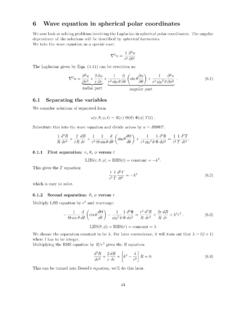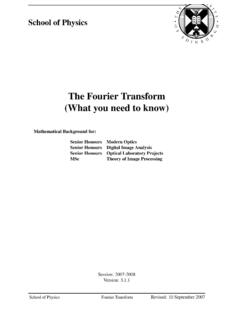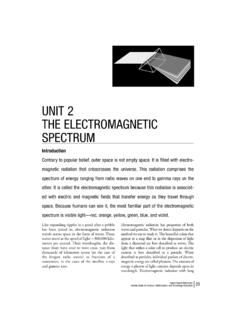Transcription of Lecture 17 - School of Physics and Astronomy
1 Lecture 17 Perturbation Theory147148 Lecture 17. PERTURBATION IntroductionSo far we have concentrated on systems for which we could find exactly the eigenvalues andeigenfunctions of the Hamiltonian, like the harmonic oscillator, the quantum rotator, orthe hydrogen the vast majority of systems in Nature cannot be solved exactly, and we needto develop appropriate tools to deal with theory is extremely successful in dealing with those cases that can be mod-elled as a small deformation of a system that we can solve us translate the above statement into a precise mathematical framework. We aregoing to consider systems that have an Hamiltonian: H= H0+ V,( )where H0is the Hamiltonian of the unperturbed system, is a small parameter, and Vis the potential describing the perturbation.
2 We shall assume that the perturbationVisindependent of us also assume that we can solve the time-independent Schr odinger equation for H0, that we know its eigenvalues and eigenfunctions: H0 (n)(x)=E(n) (n)(x).( )For simplicity we start by considering the case where all the unperturbed levelsE(n)are Perturbative solutionLet us discuss the solution of the time-independent Schr odinger equation for the full Hamil-tonianH. The eigenvalue equation reads: H (x)=E (x).( )Since is a small parameter, we shall expand the solution of Eq. ( ) as a Taylor seriesin : (x)= 0(x)+ 1(x)+ 2 2(x)+..,( )E=E0+ E1+ 2E2+..( )Plugging Eqs. ( ) and ( ) into Eq.
3 ( ), we obtain: H0+ V 0(x)+ 1(x)+ 2 2(x)+.. = E0+ E1+ 2E2+.. 0(x)+ 1(x)+ 2 2(x)+..( )We can now solve Eq. ( ) order by order in . PERTURBATIVE SOLUTION149 Order 0At order 0we find: H0 E0 0=0,( )and therefore 0has to be one of the unperturbed eigenfunctions (n), andE0must be thecorresponding unperturbed eigenvalueE(n). Since we assumed that the unperturbed levelsare nondegenerate the choice of (n)is 1At order we have: H0 E0 1+ V E1 0=0.( )Taking the scalar product of Eq. ( ) with 0yields: 0| H0| 1 + 0| V| 0 =E0 0| 1 +E1 0| 0 .( )Since H0is Hermitean, the first term on the LHS of Eq. ( ) cancels with the first term onthe RHS, and we are left with:E1= 0| V| 0 0| 0.
4 ( )To first order in the perturbation parameter , the shift of then-th energy eigenvalue is givenby Eq. ( ). Hence the eigenvalue of the Hamiltonian is:E=E(n)+ (n)| V| (n) (n)| (n) +O( 2).( )This is a very useful result, since it allows us to compute the perturbed energy levels startingfrom the unperturbed us now consider the scalar product of Eq. ( ) with (m), for (m) = 0: (m)| H0| 1 + (m)| V| 0 =E0 (m)| 1 +E1 (m)| 0 .( )Using the fact that: (m)| 0 =0,( )we obtain: (m)| 1 = (m)| V| 0 E0 E(m).( )Hence at first order in we have: (x)= (n)(x)+ m =n (m)| V| (n) E(n) E(m) (m)(x)+O( 2).( )150 Lecture 17. PERTURBATION THEORYU sing Dirac s notation, we can rewrite the solution above as:| =| (n) + m =n (m)| V| (n) E(n) E(m)| (m) +O( 2).
5 ( )Note that to first order in the solution in Eq. ( ) is already normalized: | = (n)| (n) + m =n (m)| V| (n) E(n) E(m) (n)| (m) + +O( 2)( )=1+O( 2).( )ExampleA particle moves in the 1-dimensional potentialV(x)= ,|x|>a,V(x)=V0cos( x/2a),|x| aCalculate the ground-state energy to first order in perturbation we take the unperturbed Hamiltonian, H0, to be that of the infinite square well, forwhich we already know the eigenvalues and eigenfunctions:E(n)= 2 2n28ma2,u(n)=1 a cossin n x2a;n oddeven The perturbation H isV0cos( x/2a), which is small providedV0 E(2) E(1).To first order, then, E E1=H 11= u(1) H u(1)dx=V0a a acos3 x2adxEvaluating the integral is straightforward and yields the result E=8V03 = solutionAt order Lthe eigenvalue equation yields: H0 E0 L+ V E1 L 1 L K=2EK L K=0.
6 ( )Taking the same scalar products described above, we find:EL= 0| V| L 1 ,( ) DEGENERATE LEVELS151which yields the correction of order Lto the unperturbed energy the computation above we also obtain: (m)| L = (m)|V| L 1 E(n) E(m) 1E(n) E(m)L 1 K=1EK (m)| L K .( )Using Eq. ( ) forL= 2 we find the second-order correction to then-th energy level:E2= 0| V| 1 = m =n (n)| V| (m) (m)| V| (n) E(n) E(m).( ) Degenerate levelsEquation ( ) shows that the correction to the energy eigenfunctions at first order inperturbation theory is small only if (m)| V| (n) E(n) E(m) 1.( )If the energy splitting between the unperturbed levels is small compared to the matrix elementin the numerator, then the perturbation becomes large, and the approximation breaks particular, if there are degenerate levels, the denominator is singular, and the solution isnot us see how we can deal with ag0-fold degenerate level of the unperturbed shall denotePthe projector onto such level, andQthe projector orthogonal to this first-order equation: H0 E0 1+ V E1 0= 0( )can be projected usingPonto the space spun by the degenerate states:P V E1 0=0.
7 ( )Choosing a basis for the space of degenerate levels, we can write 0as: 0=g0 i=1ci i,( )and then rewrite Eq. ( ): i| V| j cj=E1ci,( ) an eigenvalue of the matrixVij= i| V| j . This equation hasg0roots (notnecessarily distinct), and generalizes Eq. ( ) to the case of degenerate levels. If theeigenvalues are indeed all distinct, then the degeneracy is completed lifted. If some of theeigenvalues are equal, the degeneracy is only partially 17. PERTURBATION THEORYE xampleA well-known example of degenerate perturbation theory is the Stark effect, separation of levels in the H atom due to the presence of an electric field. Let us considerthen= 2 level, which has a 4-fold degeneracy:|2s ,|2p,0 ,|2p,+1 ,|2p, 1.
8 ( )The electric field is chosen in thez-direction, hence the perturbation can be written as:V= ezE,( )whereEis the magnitude of the electric need to compute the matrixVijin the subspace of the unperturbed states of the Hatom withn= 2. This is a 4 4 Hermitean that the perturbationVis odd under parity, and therefore it has non-vanishingmatrix elements only between states of opposite parity. Since the eigenstates of the H atomare eigenstates ofL2andLz, we find that only the matrix elements betweensandpstatescan be different from ,Vcommutes withLzand therefore only matrix elements between states withthe same value ofLzare different from we have proved that the only non-vanishing matrix elements are 2s| V|2p,0 and itsHermitean conjugate.
9 Hence the matrixVis given by: 03eEa0003eEa000000000000 ,( )wherea0is the Bohr radius. We see that the external field only removes the degeneracybetween the|2s , and the|2p,0 states; the states|2p, 1 are left two other levels are split:E=E2 3ea0E.( ) ApplicationsThere are numerous applications of perturbation theory, which has proven to be a veryeffective tool to gain quantitative information on the dynamics of a system whenever a smallexpansion parameter can be we discuss briefly two Ground state of HeliumWe can now attempt to incorporate the effect of the inter-electron Coulomb repulsion bytreating it as a perturbation.
10 We write the Hamiltonian as H= H0+ H where H0= H1+ H2and H =e24 0|r1 r2|The ground state wavefunction that we wrote down earlier is an eigenfunction of theunperturbed Hamiltonian, H0; (ground state) =u100(r1)u100(r2) 0, compute the first order correction to the ground state energy, we have to evaluate theexpectation value of the perturbation, H , with respect to this wavefunction; E1=e24 0 u 100(r1)u 100(r2) 0,01r12u100(r1)u100(r2) 0,0d 1d 2 The scalar product of 0,0with its conjugate = 1, since it is normalised. Putting in theexplicit form of the hydrogenic wavefunction from Lecture 10u100(r)=1 (Z/a0)3/2exp( Zr/a0)thus yields the expression E1=e24 0 Z3 a30 2 1r12exp{ 2Z(r1+r2)/a0}d 1d 2 Amazingly, this integral can be evaluated analytically.
















